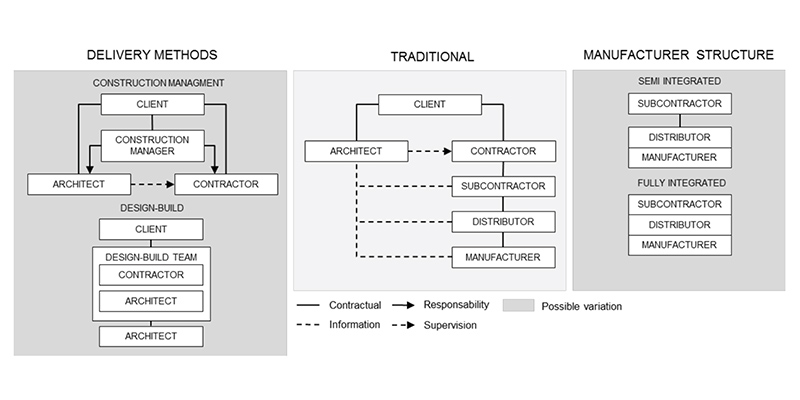Downloads
DOI:
https://doi.org/10.7480/jfde.2018.1.1811Keywords:
material selection, cladding, decision-making, non-residential construction, construction stakeholdersAbstract
Designing the facade of a building is a complex task due to the multiple criteria to consider and the number of stakeholders involved. This paper highlights the influence criteria, the requirement and the issues relative to the selection of cladding material for non-residential buildings. Architects, contractors, subcontractors and clients provide a systemic view of the situation, based on an analysis of the findings from a mixed-research method combining online survey and semi-structured interviews. The results show that the decision for the cladding material is mainly influenced by building type, client type, project context, personal experience, product reputation and project delivery methods. The most important requirement for architects, in terms of cladding materials are, in order, performance, appearance, and good warranties. Contractors and subcontractors look especially for compliance with the delivery schedule, with an optimal deadline of less than three weeks. Regarding installation, subcontractors seek speed of installation, system simplicity, easy coordination with envelope workers and on-site product modulation. Finally, the main issues with cladding are maintenance, newness of cladding systems, lack of construction detail, and tendering process. A better understanding of the cladding selection process provides valuable insight to the manufacturer in order to provide the right information to satisfy stakeholder’s need.
How to Cite
Published
Issue
Section
License
Copyright (c) 2018 Samuel Guy-Plourde, Pierre Blanchet, Michel de Blois, Francois Robichaud, Costel Barbuta

This work is licensed under a Creative Commons Attribution 4.0 International License.
Authors or their institutions retain copyright to their publications without restrictions.
References
Akadiri, P. O., & Olomolaiye, P. O. (2012). Development of sustainable assessment criteria for building materials selection. Engineering, Construction and Architectural Management, 19(6), 666–687.
Amaratunga, D., Baldry, D., Sarshar, M., & Newton, R. (2002). Quantitative and qualitative research in the built environment: application of “mixed” research approach. Work Study, 51(1), 17–31.
http://doi.org/10.1108/00438020210415488
ASHRAE. (2007). Standard 90.1 - Normative Appendix B Building Envelope Climate Criteria. The American Society of Heating, Refrigerating and Air-Conditioning Engineers.
Blanchet, A., & Gotman, A. (2007). L’entretien (2e édition). Paris: Armand Colin.
Borden, G. P. (2009). Material Precedent: The Typology of Modern Tectonics. 97th Association of Collegiate Schools of Architecture, 92–101.
Chen, Y., Okudan, G. E., & Riley, D. R. (2010). Sustainable performance criteria for construction method selection in concrete buildings. Automation in Construction, 19(2), 235–244.
Damery, D. T., & Fisette, P. (2001). Decision making in the purchase of siding: a survey of architechts, contractors and homeowners in the U.S. northeast. Forest Products Journal, 51(7), 29–36.
Dillman, D. A., Smyth, J. D., & Christian, L. M. (2014). Internet, Phone, Mail, and Mixed-Mode Surveys: The Tailored Design Method (4th ed.). Wiley Publishing.
Drouin, M., Blanchet, P., & Beauregard, R. (2013). Characterization of the Design Function in the Appearance Wood Products for Nonresidential Buildings: A conceptual Framework. The International Journal of Designed Objects, 6(3), 1–16.
Du, Q. (2009). Integrated decision making int the cladding supply chain. University of Bath.
Forest Products Association of Canada. (2013). From surviving to thriving - Canada’s forest products industry in the 21st century. Vancouver, Canada.
Garmston, H., Pan, W., & De Wilde, P. (2012). Decision-making in façade selection for multi-storey buildings. 28th Annual Conference of the Association of Researchers in Construction Management, ARCOM 2012, (September), 357–367.
Gorse, C., Johnston, D., & Pritchard, M. (2012). A Dictionary of Construction, Surveying and Civil Engineering. Oxford: Oxford University Press.
Groat, L., & Wang, D. (2002). Architectural Research methods. New-York: John Wiley & Sons, Inc.
Hegger, M., Auch-Schwelk, V., Drexler, H., & Zeumer, M. (2006). Construction materials manual. Basel: Birkhäuser.
Hegger, M., Drexler, H., & Zeumer, M. (2007). Basics Materials. Birkhäuser.
Herzog, T., Krippner, R., & Lang, W. (2007). Construire des façades. Lausanne: PPUR.
Johnson, R. A., & Bhattacharyya, G. K. (1996). Statistics: Principles and Methods. New-York: Wiley.
Kalian, A., Watson, A., Agbasi, E., Anumba, C., & Gibb, A. (2004). Modelling the building cladding attainment processes. Business Process Management Journal, 10(6), 712–723.
Kassem, M., & Mitchell, D. (2015). Bridging the gap between selection decisions of facade systems at the early design phase: Issues, challenges and solutions. Journal of Facade Design and Engineering, 3(2), 165–183.
Kozak, R. A., & Cohen, D. H. (1999). Architects and structural engineers: An examination of wood design and use in nonresidential construction. Forest Products Journal, 49(4), 37–46.
Ledbetter, S. (2003). Communication in the cladding supply chain. Facade Design and Procurement. April 2003, Bath.
Mucchielli, A. (1996). Dictionnaires des méthodes qualitatives en sciences humaines et sociales. Paris: Armand Colin.
O’Connor, J., Fell, D., & Kozak, R. (2004). Potential for increased wood-use in North American nonresidential markets, Part II - Builder/owner survey (Project No. 3917).
Forintek Canada Corp., Vancouver, Canada.
Oppenheim, A. N. (2000). Questionnaire design, interviewing and attitude measurement. Bloomsbury Academic.
Pan, W., Dainty, A. R. J., & Gibb, A. G. F. (2012). Establishing and Weighting Decision Criteria for Building System Selection in Housing Construction. Journal of Construction Engineering and Management, ASCE, 138(11), 1239–1250.
Pires, A. (1997). Échantillonnage et recherche qualitative : essai théorique et méthodologique. In La recherche qualitative : enjeux épistémologiques et méthodologiques (pp. 113–169). Montréal: Gaëtan Morin.
Royal Architectural Institute of Canada. (2009). Modes de réalisation des projets de construction. In Institut royal d’architecture du Canada (Ed.), Manuel canadien de pratique de l’architecture.
Šaparauskas, J., Kazimieras Zavadskas, E., & Turskis, Z. (2011). Selection of Facade’s Alternatives of Commercial and Public Buildings Based on Multiple Criteria. International Journal of Strategic Property Management, 15(2), 189–203.
Singhaputtangkul, N., Low, S. P., Teo, A. L., & Hwang, B.-G. (2014). Criteria for architects and engineers to achieve sustainability and buildability in building envelope designs. Journal of Management in Engineering, 30(2), 236–245.
Wastiels, L., & Wouters, I. (2011). Architects’ considerations while selecting materials. Materials and Design, 34, 584–593.
